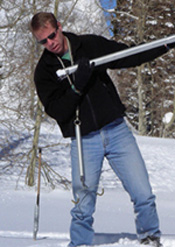2012 Snowpack Lacking
Mild weather and below normal snowpack cause concern over next year's water supply.
February 22, 2012
LeRoy W. Hooton, Jr.
Public Utilities hydrology specialist Larry Alserda as viewed in 2008 measuring snowpack SWE in the Wasatch Canyons

Let’s face it, the weather in Utah is fickle. Last year at this time we were looking at copious snowpack in our watersheds, which during the spring foreboded high streamflows with potential flooding. Numerous snowpack records were set within many of the state's sub-basins. The snowpack in the Provo River – Utah Lake – Jordan River basin was over 200 percent of normal Snow Water Equivalent (SWE). Likewise, the snowpack in the Wasatch Mountains was well above normal. According to forecasts for the six creeks in Salt Lake County, streamflows were predicted to be 191 per cent of normal. Fortunately, aided by flood control improvements made after the floods of the 1980s, and favorable weather conditions the high spring snowmelt flows were mitigated avoiding any serious flooding in the Salt Lake valley.
This year the snowpack is the antithesis of last year – the weather has been mild with a dearth of snowpack building up in the watersheds According to Public Utilities hydrology specialist Larry Alserda, the February 1 snowpack in the Wasatch Mountains east of Salt Lake City was only 60 percent of normal. Likewise, the snowpack at Trial Lake, which produces the run-off flows in the Provo River that supplies water to the Metropolitan Water District of Salt Lake & Sandy was only 52 percent of normal.
These conditions pretty well exist throughout the state – and in fact most of the U. S., except for Alaska which has record snowfall this winter. The snowpack in the Colorado River Upper Basin above Glen Canyon Dam is 69 percent of normal. And the water content in the Sierra Nevadas snowpack is only 38 percent on February 1. Based on these current conditions, California's water users may have their water supply curtailed if the current trend continues.
Looking to the remaining winter months, there is a possibility that conditions may improve in Utah. According to Natural Resource Conservation Service snow survey supervisor Randy Julander, “... statistically when snowpacks start off very low – less than 75 percent of normal, they have a high probability of improvement through the remaining months – about 80 percent of the time they will likely increase on average about 20 to 30 percent, which would put our snowpack at 50 -80 percent of normal at the end of winter.” Julander notes that current statewide snowpack conditions are similar to those of 1977, which started out well below normal, but due to a wet spring ultimately nearly reached normal conditions. On the other hand, he warns that it's possible that conditions could get worse.
In regards to the local Wasatch canyon watersheds, Alserda believes that it's unlikely that we will totally recover from the lack of storms so far, but he's hopeful that the jet stream will change course and steer more storms into the Western United States and improve the spring (March-April) snowpack in the canyon watersheds. Another factor that may increase the odds of improving the snowpack this spring is the current La Niņa conditions in the Pacific Ocean, which normally causes more precipitation to fall in the northern part of the state.
Reservoir storage carry-over from last year will help bolster water supplies this year. Last year's phenomenal snowpack filled the state's reservoirs, which will be available for water supply this year. Statewide reservoir storage is now 84 percent capacity. Even with lower than normal snowpack and run-off this spring, these reservoirs will fill. Salt Lake City receives most of its stored water from Jordanelle, Deer Creek and Mt. Dell – Little Dell reservoirs. The two largest reservoirs on the Provo River, Jordanelle and Deer Creek have 270,000 acre-feet (86%) and 143,000 acre-feet (94%) of storage capacity respectively. On the Colorado River, Lake Mead has risen 42.45 feet in elevation during the past year, reversing the downward trend of this key reservoir.
Another factor that will help next year's water supply is the soil moisture content, which is still about normal throughout the state.
On the bright side, even though there are wet and dry cycles, it's fortunate this year that last year was very wet with a plethora of water, which will help carry us through what appears to be a dry year.